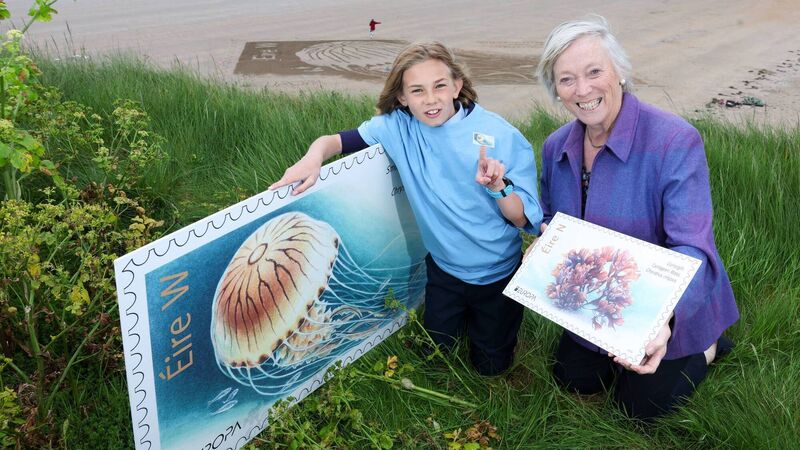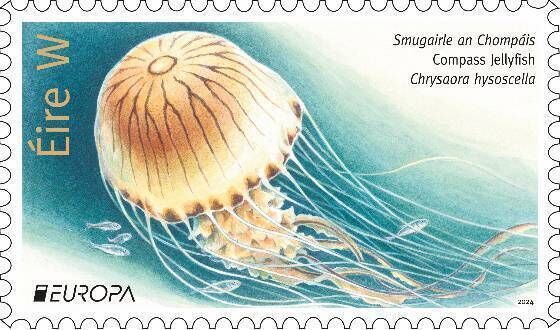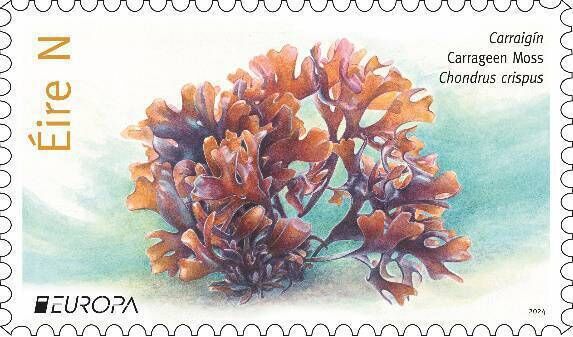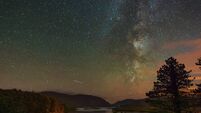Talking common sense, clean-ups and jellyfish with Éanna Ní Lamhna

Nico De Marchis (aged 11) and biologist and environmentalist Éanna Ní Lamhna on Rush Beach, Dublin, as An Post calls on the public to support its Beach and Waterways Clean-Up Day on June 8 and unveils its beautiful new marine life stamps, These marine life stamps are available online at anpost.com/shop or in-store at selected post offices nationwide from Thursday, June 6
"Well, a jellyfish can't make a speech to justify itself to humans so does that mean it shouldn't exist?"
A common reaction to spotting jellyfish on the beaches and in warm water is horror and warnings about stings and dangers. But biologist, environmentalist, author and educator Eanna Ní Lamhna is keen to celebrate all the good things about jellyfish and also pulls no punches in pointing out that we may well be seeing more and more of them through our own actions.
"Yes jellyfish have stings and tentacles but that's how they suck up food for themselves. And when they are small themselves they are food for fish such as cod, ling, whiting and pollock," she notes.
"We have overfished the seas, we have exceeded quotas and scraped everything so if these fish aren't there to eat the jellyfish when they are small then of course we are going to get more of them around. We are noticing more because there are more because they aren't getting gobbled up," says Ní Lamhna.
And she points out that warming oceans also bring more jellyfish to our shores: "They're not sharks, they don't swim about, they're carried along on warm currents and if the oceans are warming then they carry more jellyfish to our coasts."

It's World Ocean Day on Saturday, June 8 and An Post is marking this with two gorgeous stamps featuring Carrageen Moss and a Compass Jellyfish.
This compass jellyfish is a common species integral to local biodiversity. It harbours young fish among its tentacles, and provides a vital food source for sea turtles and ocean sunfish. "The small fish live in among the frills and are protected from bigger fish here — it's almost like a little moving coral reef," says Ní Lamhna.
World Ocean Day will also be marked here with a beach and waterways clean-up day on June 8.
An Post’s Beach and Waterways Clean Up Day is supported by waste company Panda, who will place 1,100-litre industrial bins at eight locations around the country including Garretstown Beach in Cork.
The beach clean-up initiative comes amidst the challenges of overfishing, pollution and climate change, which threaten the fragile structure of these underwater ecosystems. Even picking up a single plastic bottle or 'taking three for the sea' is important says Ní Lamhna. "Sure even one bottle would break down into millions of plastic particles."
People who leave disposable barbecues and dirty nappies 'hidden' under a thin layer of sand on beaches are among the worst culprits she says. "If someone put their foot on one of those barbecues when it's still hot they would get an awfully nasty burn and who wants children digging in the sand next to dirty nappies?"
Litter such as plastic bags are dangerous on several levels too — it looks ugly when they are dumped or wash up on the shore and also break down into microplastics but when things such as plastic packaging and bags are in the water they can be mistaken for food by turtles.
"Turtles eat jellyfish — and they eat a lot of them as there's not much to jellyfish, they're very watery. Underwater the plastic looks like jellyfish and it gets gobbled up by turtles. If it doesn't choke them and they manage to swallow it then gets stuck in their stomachs," explains Ní Lamhna.
There are more than 33,000 aquatic species living in the seas around Europe, but it's not just beaches and coastal areas that are impacted by litter and other problems, so this Clean-Up Day also focuses on inland water areas.
Inland waters including streams, rivers, floodplains, lakes and swamps are home to around 100,000 animals and plants.
An Post is encouraging everyone to take the time to rediscover their local beauty spots and is urging people to bring home any litter they find, ultimately helping to preserve our underwater ecosystems.

The other Europa stamp from An Post highlighting the rich biodiversity found in Europe's waters features Carrageen Moss. This is a colourful fan-shaped algae found along the Irish coast and it has been an important food, fertiliser, and medicinal food for centuries.
"Carrageen moss is full of mucilage — slippery stuff — so when you boil it it sets like jelly. And if you add milk or cream then you have what we used to call blacmange but it makes wonderful fancy things like panna cotta which is so popular now. And it's good for protein too so that's great," says Ní Lamhna.
And there's no need to be nervous about foraging for seaweed in the same way that people might be fearful of picking the 'wrong' mushroom and being poisoned.
"Some seaweeds like leathery kelp you wouldn't pick anyway as it's so tough you couldn't eat it and some maybe wouldn't taste great but there aren't any poisonous ones so you don't have to worry about that. But carrageen moss and dulse (dilsk) are easily identifiable anyway," she says.
Any plastic litter picked up at beaches on , can of course be brought home for recycling but waste company Panda will have 1,100-litre industrial bins at these eight locations:
- Athlone - Lough Ree (Lake)
- Donegal - Rathmullan Beach (Beachside)
- Dublin - Portmarnock (N) - Portmarnock Beach (Beachside)
- Kinsale - Garretstown Beach (Beachside)
- Kerry – Banna Beach (Beachside)
- Wexford – Rosslare Strand (Beachside)
- Sligo – Enniscrone (Beachside)
- Louth - Clogher Head (Beachside)





